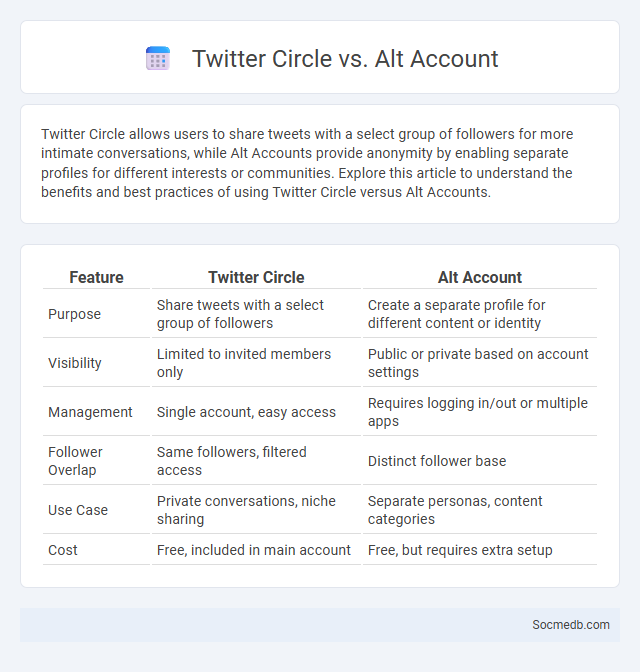
Photo illustration: Twitter Circle vs Alt Account
Twitter Circle allows users to share tweets with a select group of followers for more intimate conversations, while Alt Accounts provide anonymity by enabling separate profiles for different interests or communities. Explore this article to understand the benefits and best practices of using Twitter Circle versus Alt Accounts.
Table of Comparison
| Feature | Twitter Circle | Alt Account |
|---|---|---|
| Purpose | Share tweets with a select group of followers | Create a separate profile for different content or identity |
| Visibility | Limited to invited members only | Public or private based on account settings |
| Management | Single account, easy access | Requires logging in/out or multiple apps |
| Follower Overlap | Same followers, filtered access | Distinct follower base |
| Use Case | Private conversations, niche sharing | Separate personas, content categories |
| Cost | Free, included in main account | Free, but requires extra setup |
Introduction to Twitter Circle and Alt Accounts
Twitter Circle allows you to share tweets with a select group of followers, enhancing privacy and targeted communication on your account. Alt accounts on Twitter serve as secondary profiles for exploring different interests or separating personal opinions from professional identities. Managing your Twitter Circle and alt accounts effectively can improve your online presence and control over shared content.
What is Twitter Circle?
Twitter Circle is a feature that allows you to share tweets with a select group of up to 150 people, creating a private audience distinct from your public followers. This tool enhances your control over who sees your content, offering a more intimate and tailored interaction on the platform. By using Twitter Circle, you can foster closer connections and share thoughts without broadcasting to your entire Twitter community.
What is an Alt Account on Twitter?
An alt account on Twitter is an alternative profile created by a user to separate different aspects of their online presence or to engage anonymously. These secondary accounts allow you to explore topics, interact with communities, or share opinions without linking to your primary identity. Alt accounts provide flexibility in managing your social media experience while maintaining privacy or creative freedom.
Features Comparison: Twitter Circle vs Alt Account
Twitter Circle offers a private sharing option allowing you to limit tweets to a select group of up to 150 people, enhancing content control and privacy. Alt Account provides the ability to create separate profiles, enabling content segregation and targeted interaction without mixing audiences. Your choice depends on whether you prioritize exclusive audience engagement with Twitter Circle or maintaining distinct identities through Alt Accounts.
Privacy and Security: Which Option is Better?
Social media platforms vary significantly in their privacy and security features, with options like end-to-end encryption, two-factor authentication, and strict data-sharing policies offering enhanced protection. Users should prioritize platforms that minimize data collection and provide transparent control over personal information to reduce risks of breaches and unauthorized access. Evaluating each platform's privacy settings, data encryption standards, and history of security incidents is essential for selecting the safer option.
Ease of Use: Circle vs Alt Account
Circle offers an intuitive interface that simplifies account switching, making it easier for you to manage multiple profiles without confusion. Alt Account provides customizable settings but may require a learning curve to navigate its features efficiently. Both platforms prioritize ease of use, but Circle stands out for seamless and quick transitions between accounts.
Content Control: Managing Your Audience
Effective content control on social media involves strategically managing your audience by tailoring posts to resonate with specific demographics and using privacy settings to limit reach. Analyzing engagement metrics helps identify which types of content foster meaningful interactions and maintain community standards. You can enhance your brand's reputation by consistently curating content that aligns with your goals and audience preferences.
Pros and Cons: Twitter Circle
Twitter Circle enables users to share tweets exclusively with a selected group, enhancing privacy and fostering intimate conversations within a trusted audience. The main advantage lies in controlling content visibility, reducing unwanted interactions and potential online harassment. However, the limitation of Twitter Circle includes restricted reach, as tweets do not extend beyond chosen members, potentially limiting engagement and exposure.
Pros and Cons: Alt Account
Creating an alt account on social media offers significant privacy benefits, allowing you to explore interests and express opinions without impacting your main profile's reputation. However, managing multiple accounts can lead to time consumption and potential confusion, reducing overall productivity. You should weigh the anonymity and freedom against the risk of account suspension or inconsistent personal branding before committing to an alt profile.
Which Option Should You Choose?
Choosing the right social media platform depends on your specific goals, target audience, and content type. Platforms like Instagram and TikTok excel for visual and short-form video content, while LinkedIn is ideal for professional networking and B2B marketing. Understanding your audience demographics and engagement preferences ensures your social media strategy maximizes reach and impact for your brand or business.
 socmedb.com
socmedb.com